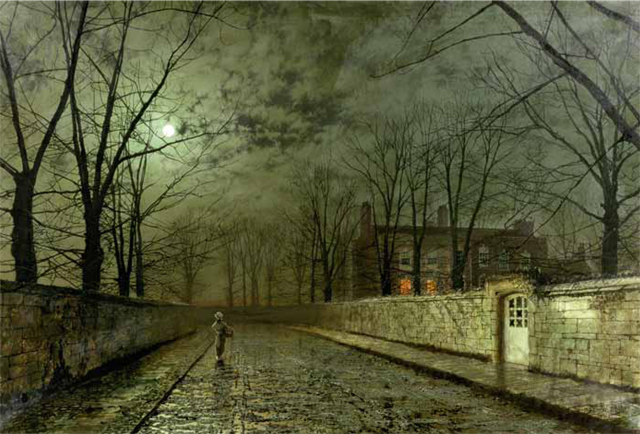My Favourite Painting: Dame Hilary Mantel
Dame Hilary Mantel chooses her favourite painting for Country Life.


Silver Moonlight, 1880, by John Atkinson Grimshaw (1836–93), 32in by 47in, Harrogate Museums and Arts, North Yorkshire. Bridgeman Images.
Dame Hilary Mantel says: 'The mystery is why I’m drawn to these nocturnes by the artist known as Grimmy. I feel as if I have crept through his wet, shining streets, hugging the wall, in a dream or something like a previous life. This example also seems to illustrate the opening pages of Mother and Son by Ivy Compton-Burnett, one of my favourite novelists.'
Hilary Mantel is the only female author to have won the Booker Prize twice—for the first two parts of her Thomas Cromwell trilogy. She is currently working on the third instalment, The Mirror and the Light
John McEwen comments: ‘The lady has arrived, ma’am. She has found her way,’ said the parlourmaid, with a change in her tone. ‘Found her way? What do you mean?’ ‘Along the road from the station, ma’am. Under the shadow of all those trees. The dusk is already threatening.’ From the opening page of ‘Mother and Son’ by Ivy Compton-Burnett
'Most parents inwardly groan when their offspring announce that they want to be artists. Grimshaw’s strictly non-conformist mother threw his paints on the fire and even turned off the gas in his room when he began to paint in his spare time from clerking for the railways. He was born in Leeds, which he never deserted, a city with a notably lively Arts scene, and, despite being self taught, had made a name as a Pre-Raphaelite follower before he was 30.
The 1870s proved his most successful decade, when he sold work through the prestigious Agnew’s and had pictures accepted at the Academy. Portraits in the style of Tissot and neo-Classic fantasies preceded the urban and suburban scenes of Tennysonian melancholy for which he is best known. ‘Moonlights’ became his trademark. His father was a policeman and, in the ‘moonlights’, Grimshaw could be said to walk in the footsteps of a nocturnal bobby on the beat.
An unexplained financial disaster forced him to increase his output in the 1880s. He added London to his previously northern urban repertoire and briefly even maintained a London studio. A high rate of production was sustained until his death, but from then until the 1950s, he was almost completely forgotten.'
Sign up for the Country Life Newsletter
Exquisite houses, the beauty of Nature, and how to get the most from your life, straight to your inbox.
This article was first published in Country Life, August 21, 2013
Country Life is unlike any other magazine: the only glossy weekly on the newsstand and the only magazine that has been guest-edited by HRH The King not once, but twice. It is a celebration of modern rural life and all its diverse joys and pleasures — that was first published in Queen Victoria's Diamond Jubilee year. Our eclectic mixture of witty and informative content — from the most up-to-date property news and commentary and a coveted glimpse inside some of the UK's best houses and gardens, to gardening, the arts and interior design, written by experts in their field — still cannot be found in print or online, anywhere else.
-
 Six rural properties with space, charm and endless views, as seen in Country Life
Six rural properties with space, charm and endless views, as seen in Country LifeWe take a look at some of the best houses to come to the market via Country Life in the past week.
By Toby Keel
-
 Exploring the countryside is essential for our wellbeing, but Right to Roam is going backwards
Exploring the countryside is essential for our wellbeing, but Right to Roam is going backwardsCampaigners in England often point to Scotland as an example of how brilliantly Right to Roam works, but it's not all it's cracked up to be, says Patrick Galbraith.
By Patrick Galbraith
-
 My favourite painting: Allan Mallinson
My favourite painting: Allan MallinsonMilitary historian Allan Mallinson picks an image of 'faith, generosity and ultimate sacrifice'.
By Charlotte Mullins
-
 My Favourite Painting: Piet Oudolf
My Favourite Painting: Piet Oudolf'One cannot sense whether he is far out on the ocean or closer to shore, or what he may be watching or feeling in that moment as he stares towards the beach.’
By Country Life
-
 My Favourite Painting: Mary Plazas
My Favourite Painting: Mary Plazas'There is compassion, awe, humility, a knowing yet a questioning in the glistening eyes. It moves me, it inspires me beyond the need to know.’
By Country Life
-
 My favourite painting: Robert Kime
My favourite painting: Robert KimeRobert Kime shares his fondness for New Year Snow by Ravilious
By Country Life
-
 My Favourite Painting: Anna Pavord
My Favourite Painting: Anna PavordAnna Pavord chooses a picture which reminds her of where she grew up
By Country Life
-
 My favourite painting: The Duchess of Wellington
My favourite painting: The Duchess of WellingtonThe Duchess of Wellington chooses her favourite painting for Country Life.
By Country Life
-
 My favourite painting: Maureen Lipman
My favourite painting: Maureen LipmanMaureen Lipman chooses her favourite painting for Country Life.
By Country Life
-
 My favourite painting: Jacqueline Wilson
My favourite painting: Jacqueline Wilson'I looked at this painting and decided to write about a Victorian circus girl one day'
By Country Life